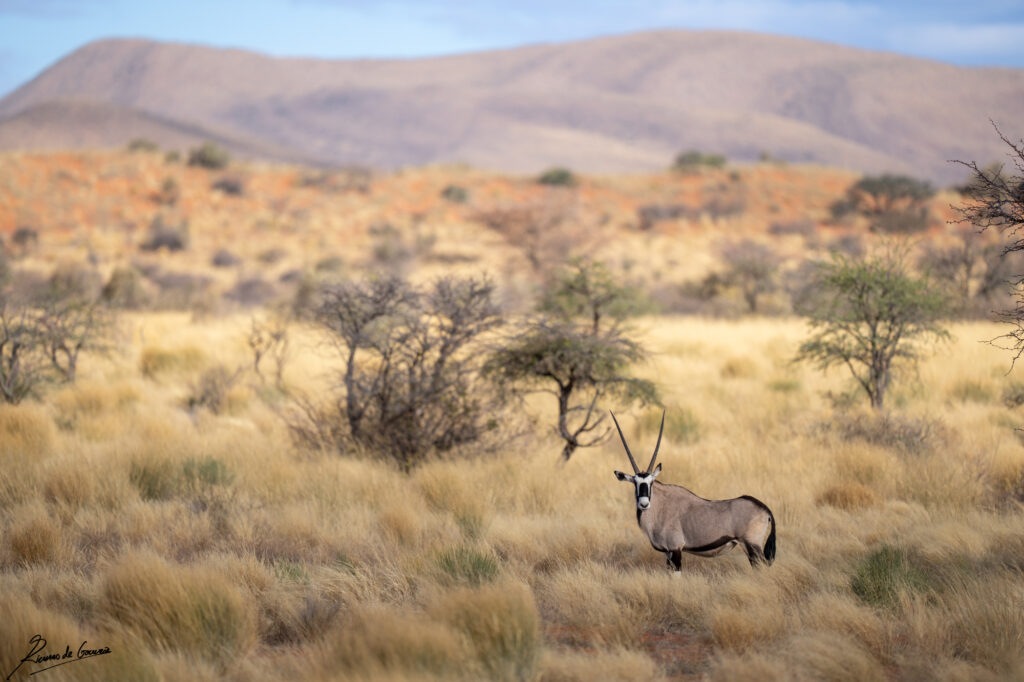A journey to the Green Kalahari
Sara • 12/08/2023
SHARE
As we traversed the dense rainforests and darted alongside the elusive rhinos, our adventure led us to a starkly contrasting landscape, where the sands of the Kalahari whispered tales of resilience and rebirth. Our final destination, Tswalu Kalahari, South Africa’s most extensive privately protected conservation area, beckoned with a promise of new beginnings.
In the far reaches of the Northern Cape province, the Kalahari’s vast expanse stretched into the horizon, revealing a land defined by extremes and unforgiving contrasts, where life’s very essence hinged on the presence or absence of water. This is where Tswalu found its home, nestled at the southernmost edge of the Kalahari, where the true Kalahari ecotype gracefully merged into arid savannah.
The name ‘Tswalu’ carried profound meaning, for it signified ‘rebirth’ or ‘new beginning’ in Setswana. It encapsulated a bold vision – a vision to resurrect the biodiversity of this ancient land, a place where survival danced on the fine line between water’s scarcity and abundance. Here, the reserve stood as the guardian of a significant piece of the Kalahari ecosystem, a sanctuary where vital habitat was safeguarded, and biodiversity had the opportunity to flourish once more, enriching both the planet and its people.
The story of Tswalu is a labor of love that traces back to 1999 when the Oppenheimer family assumed responsibility for this vast swathe of the southern Kalahari. They embraced the vision of the late Stephen Boler, the previous owner, who aspired to return overgrazed, farmed land to its original state. Since then, their unwavering commitment to conservation has breathed life into this ancient landscape. Indigenous species have been re-introduced, significant strides have been made towards the restoration of the Kalahari, and years of neglect have been unraveled.
Tswalu, in its new incarnation as a private nature reserve, formally protected area, and a testament to conservation success, stands as a beacon of hope. The entire Tswalu community unites in a noble endeavor – to leave the world in a better state than they found it, a promise renewed with each passing day.
Our journey continued into South Africa’s immense Savanna Biome, where Tswalu resided in a unique transition zone between the true Kalahari ecotype and arid savannah. The undulating dunes of the reserve embraced the Korannaberg mountains, which cast a benevolent shadow over the vast expanses of red dunes and rolling grasslands. This semi-arid southern Kalahari was often referred to as the ‘green Kalahari,’ a testament to the vitality hidden within its arid façade.
Tswalu offered a mosaic of five distinct habitats, each contributing to the rich diversity of species within its boundaries. Bushveld, Plains and Mountain Shrubveld, Duneveld, and Calcareous Scrubveld intertwined, providing shelter and sustenance for an array of life. The Savanna Biome’s vegetation, adapted to the harshness of limited water and extreme temperatures, created an ideal grazing ground for wildlife.
With the changing seasons, the grasses, shrubs, and trees of Tswalu responded in a delicate dance with nature. The verdant beauty of spring gave way to the brown palette of the dry winter months. After rainfall, the shrubs and trees burst into vibrant bloom, while the landscape beneath awakened with a carpet of creeping plants and ground covers.
In the foothills of the Korannaberg mountains, the Eastern Kalahari Bushveld offered grassy plains punctuated by clusters of trees and shrubs. The Plains Shrubveld introduced lower-growing woody shrubs, including thorny marvels that painted the land with white flowers in spring. Mountain Shrubveld thrived along the Korannaberg range, a realm of quartzite rocks softened by the hardy shrubs and evergreen kuni-bush.

The wind-sculpted sands of the Duneveld, with their shifting dunes, were home to dune grasses and resilient trees. Calcrete Scrubveld covered the western areas, where nutritious grasses coexisted with scrub, shepherd’s trees, and camel thorns.
In the grand tapestry of habitat conservation, diversity emerged as strength. The more diverse the habitats within an ecosystem, the better the system and its inhabitants could adapt to change. In the green Kalahari, nestled within its arid vegetation types, the battle against climate change loomed large, and ongoing monitoring stood as the key to the conservation and protection of this priceless wilderness area.

Tswalu Kalahari, with its vivid contrast to the rainforests and rhino-filled plains we had journeyed through, was a testament to nature’s resilience and the enduring spirit of those who stood as its guardians. Our adventure reached its culmination here, as we bore witness to the harmonious coexistence of diverse habitats and the thriving biodiversity they supported, standing as a testament to the promise of rebirth and the indomitable spirit of the Kalahari.

